16 Taxonomy, Evolution and the History of Life
Learning Outcomes
By the end of this chapter you should be able to:
- Distinguish different levels in taxonomic classification;
- Distinguish between artificial and natural selection;
- Describe the processes involved in evolution by natural selection;
- Explain what is a fossil;
- Give an account of major changes in the Biosphere during the Archean, Proterozoic, and Phanerozoic eons.
Taxonomy
The living world is divided up into categories of life, which we recognize when we talk about “plants”, “insects”, “horses” or Tyrannosaurus rex. When we use categories like this we are using taxonomy, the classification of living things.
Species
Taxonomy is founded upon the concept of a species. What exactly is a species? When we look at living things we see a huge amount of variability, but this variability is discontinuous. To see what this means, look at modern horses, zebras and donkeys. All have certain characteristics in common. For example, they have characteristic long heads and all have feet with a single large toe that is adapted for movement with a thick hoof. However, there is a lot of variability, from small, agile fast-moving racehorses to slow, powerful plow horses. There are also differences in colouring, from grey to many shades of brown, to black and white stripes. However, there are gaps in this range of variability, so that we do not find animals that are half way between horses and zebras in their characteristics. Occasionally, a horse may interbreed with a donkey to produce an offspring called a mule, but mules are infertile, so over time we do not see a blending together of horses and donkeys; the species remain separate.
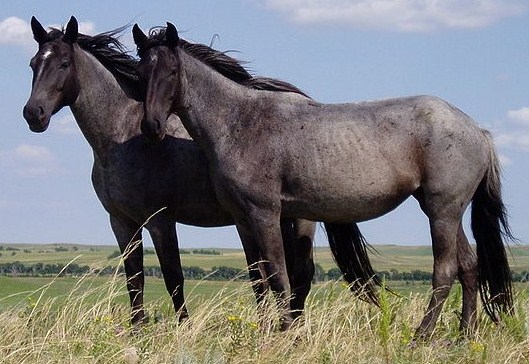
|
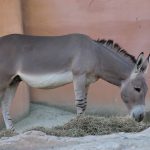 |
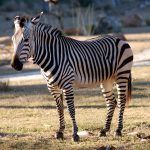 |
We can say that:
- Individuals in a species have many, but not all, characteristics in common;
- Some of the common characteristics differentiate them from other species;
- Variation within a species is much less than variation between species;
- Individuals within a species can breed with each other but do not successfully breed with members of other species.

The eighteenth-century Swedish scientist Carl von Linné 1707-1778 devised method of classifying species. Because the common language of science at the time was Latin, Linné wrote under the “Latinized” name Carolus Linnaeus, and the system he devised was based on Latin words. Even the word species is Latin.[1]
Each species received a two-part name. For example, the common horse is Equus ferus. In this case, ferus (spelled with a lowercase initial letter), is the name of the species, and Equus is the name (always spelled with an uppercase first letter) of a larger grouping called a genus.[2] Notice also that both parts of the name are written in italic script.[3]
There are about seven species in the genus Equus [4] at the present day. They include:
- E. ferus, the common horse
- E. africanus, the donkey
- E. zebra, the mountain zebra
To avoid repetition in writing, once a genus name has been mentioned once, it may be abbreviated, provided that no ambiguity results from this. Hence, the famous dinosaur Tyrannosaurus rex should always be referred to by its full name first, before the abbreviation T. rex is used[5].
Linné identified the human species as Homo sapiens. Homo[6] means “human” and sapiens means “wise” or “knowing”. Once a species is first named and defined scientifically, it doesn’t change unless someone demonstrates that the species should be split up or merged with another. Therefore, even if it could be shown that humans are not actually wise, we would be stuck with the name! [7]
Higher level groupings

Linné noted broader similarities between larger groups of organisms, and defined a hierarchy of higher level groupings which also have Latin-style names beginning with capital letters. Many have common English names too, which are usually not usually capitalized.
- Groups of genera called families. The genus Equus belongs to the family Equidae. It’s actually the only surviving genus in the family, but several extinct genera are included in the Equidae.
- Families are grouped into orders: horses and the rhinoceros belong to the order Perissodactyla.
- Orders are grouped into classes. The Perissodactyla are part of the class Mammalia, the mammals.
- A still higher category is the phylum (plural phyla). Mammals and all other vertebrates belong to the phylum Chordata, the chordates.
- Phyla are typically grouped into kingdoms, and larger domains: there are a number of slightly different classifications of living things into these groupings. One common classification works like this:
- Domain Eukarya (eukaryotes)
-
- Animalia (animals)
- Plantae (plants)
- Fungi
- Protista (single celled eukaryotes or protists)[8]
-
- Domain Eukarya (eukaryotes)
-
- Domain Bacteria
- Bacteria
- Domain Bacteria
-
- Domain Archaea
- Archea
- Domain Archaea
The organization of taxa suggests that modern organisms can be placed on a “family tree”, and the record of fossil organisms helps to fill in some of the structure of this “family tree”, back through time.

The existence of this “tree of life” suggests that organisms have evolved — changed through time in a diverging pattern that produced the present-day groupings of related, but distinct species. The mechanism of this process is the subject of the next section.
Evolution
Origin of variation: reproduction at the molecular scale
Variations that occur within a species turn out to be very important for the process of evolution. To understand those processes, we will first look at the ways in which variations arise.
Deoxyribonucleic acid (DNA) is organized into genes, each of which codes the formation of a different protein. Proteins in turn carry out the living functions of the organism. Many variations between individuals of a species are coded by small variations in the sequences of bases in the DNA.
The replication of DNA, described in an earlier section is a fundamental part of the reproduction of living things. In both meiosis and mitosis each strand of the double helix acts as a template for a new copy.
However, there are a number of reasons why the DNA of offspring is not an identical copy of parental DNA.
First, random ‘mistakes’ can occur in the copying process: the resulting changes are known as mutations. Mutations are replicated just like any other part of the DNA of a cell; therefore, mutations are passed on to later generations.
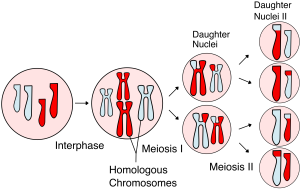
A second source of variation results from sexual reproduction, because each offspring inherits half its DNA from each parent, and there is a random element in the ‘crossover’ process whereby material from both parents gets mixed together during replication.
The proteins produced by these genetic variations may interact in new and different ways. Most mutations actually damage the survival or reproductive prospects of organisms; they are said to be deleterious. Such mutations result in death or failure to reproduce and are less likely to be passed on to future generations. However, occasional mutations, and some variations due to sharing of genetic material during reproduction, can give organisms better survival or reproductive prospects. These variations tend to be passed on to future generations.

Artificial selection
Variation has long been exploited by farmers and other breeders of animals and plants. Variations are selected with a specific purpose in mind and deliberately encouraged to mate, producing offspring with a greater chance of showing those same variations.
By breeding selected animals it has been possible to produce very diverse strains and breeds of crops and livestock. This process is known as selective breeding or artificial selection. For example, selective breeding of domestic dogs by humans has produced the enormous variety of dog breeds that exist at the present day. Selective breeding of corn, tomatoes, and cabbages for the purpose of providing food to humans has led to the production of fruits and seeds that are many times larger than those of their wild ancestors.
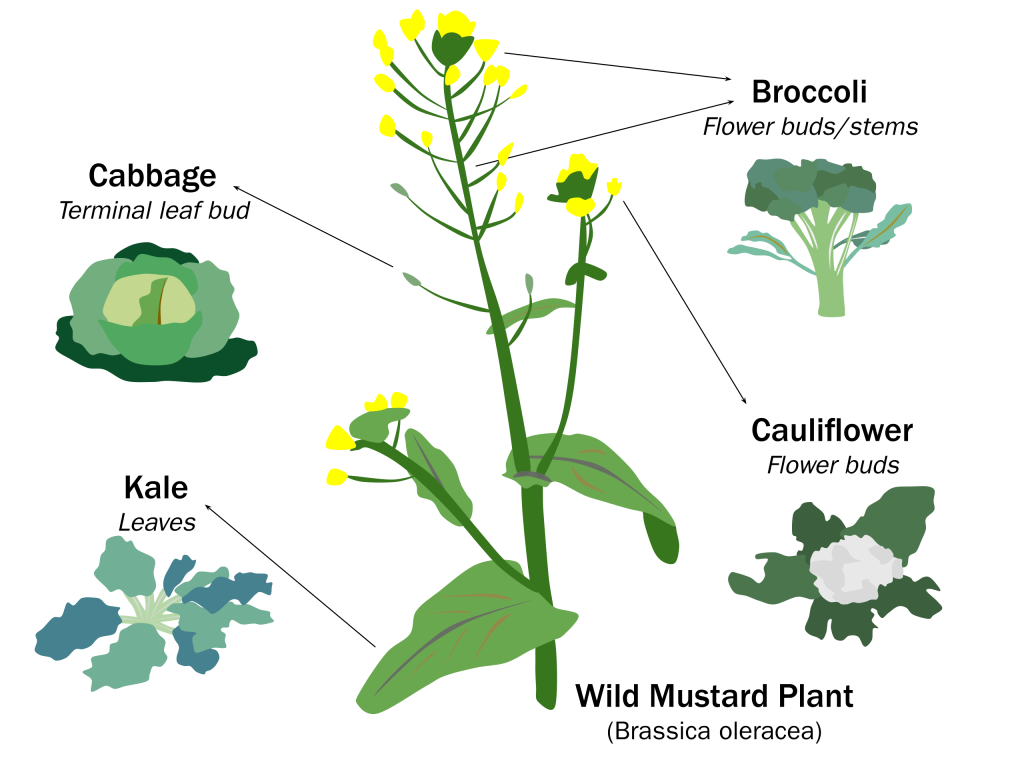
 Competition and natural selection
Competition and natural selection
Competition
In the wild, most species produce more offspring than survive to adulthood. The offspring compete for food resources, favourable locations, safety from predators, and many die before maturity. Those that do not survive to an age at which they can reproduce do not pass on their genes to the next generation.
Statistically, the offspring that survive to reproductive age are those best suited to their environment. The environment thus selects those variations that give best survival chances, playing a similar role to farmers and breeders who carry out artificial selection. We say that the environment applies selection pressure to the organism.
Natural selection
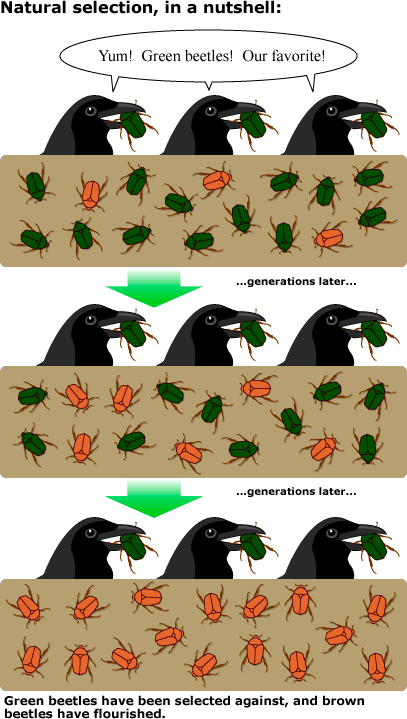
As a result of selection pressure, any variations that increase survival or reproductive chances are those most likely to be passed on to next generation. This naturally occurring change over time, in response to environmental pressure, is called natural selection. Natural selection tends to produce animals and plants whose characteristics are well adapted for survival and reproduction in the environments in which they live.
Natural selection pressure is not usually as intense as goal-directed techniques of artifical selection devised by humans, as it is dependent on many random events in the life of organisms. The process of natural selection is therefore slower than artificial selection, but it can nonetheless be observed, even over human timescales, when organisms reproduce rapidly. Over long timescales comparable with the age of the Earth, the potential of natural selection is enormous.
Environmental change
As a result of natural selection, most individuals in any given species in the wild are relatively well adapted to the environments in which they live. However, environmental change is common, and formerly well-adapted species may have their survival chances reduced by a change in their environment. As a result of such a change, a previously deleterious variation may become advantageous, and will start to “win out” in the natural selection process. The new characteristic spreads through the population, and we say that the species has evolved in response to the environmental change.
Evolution by natural selection was independently discovered by Charles Darwin (1809-1882) and Alfred Russel Wallace (1829-1923) in the mid-1800s.
A well known example is a British insect called the peppered moth. The moth typically has speckled wings that give it good camouflage on the bark of trees. There is a rare variation, probably the result of a single mutation, that produces black colouration, termed melanic. Typically, in the wild, these rare black variants were so conspicuous that they tended to be eaten by birds.
 |
 |
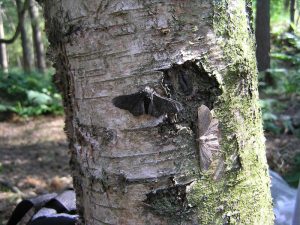
However, trees in Britain tended to be blackened by soot during industrial revolution in the 18th and 19th centuries. The typical speckled form was very conspicuous on blackened trees and is easily picked off by birds but the melanic form is well camouflaged on blackened trees. As a result of natural selection[9] the melanic form became dominant in industrial areas. The species evolved in response to pressure from another species (Homo sapiens).[10]
Interestingly, moves away from coal as fuel during the 20th century allowed the original speckled form to become more common again.
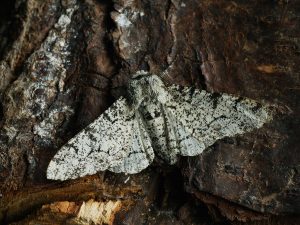
At the time of Darwin and Wallace’s work in the 19th century, nothing was known of DNA or the mechanism of inheritance. This was a problem for Darwin and Wallace’s theory of evolution, because inheritance was believed to result from an even blending of characteristics from both parents (rather than a haphazard combination). From the point of view of a nineteenth-century biologist, it was difficult to see why variations were not blended out over time. These difficulties with the theory of evolution were outstanding problems until discoveries in the 20th century, particularly in genetics (including the random processes involved in inheritance) and the role of DNA in genes.
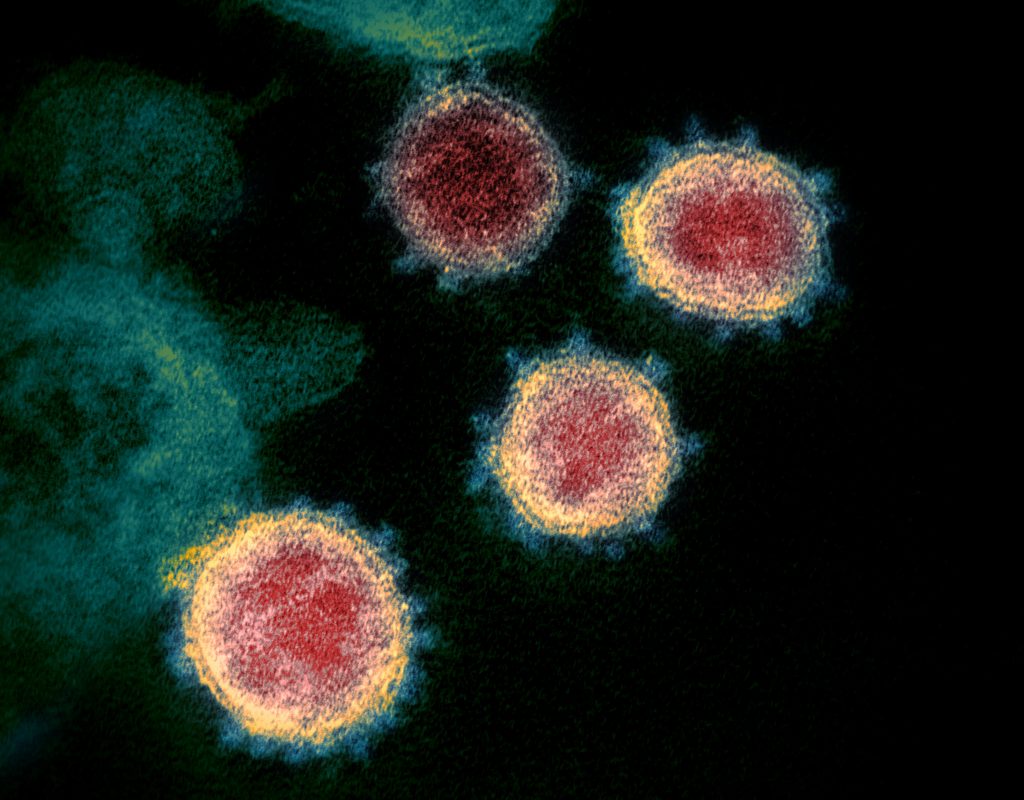
The ability of medical science to sequence DNA and RNA in the 21st century has provided unparalleled insights into evolutionary processes. During the Covid-19 pandemic of 2020-2022, it proved possible to track different mutations as the virus evolved in response to selection pressure from human immune systems and deliberate efforts by humans to counter its spread.
![]()
Speciation: evolutionary branching
Although it’s easy to see how environmental change can drive the evolution of a single species by natural selection, it’s harder to understand how a single species can branch into two different species. Nonetheless, we know from taxonomy and fossil collections that this must have happened thousands of times in the history of life.
The easiest way for one species to split into two, producing two branches in the evolutionary tree, is when populations of a single species become geographically isolated from one another for a time. This isolation allows the two populations to respond to different selection pressures.
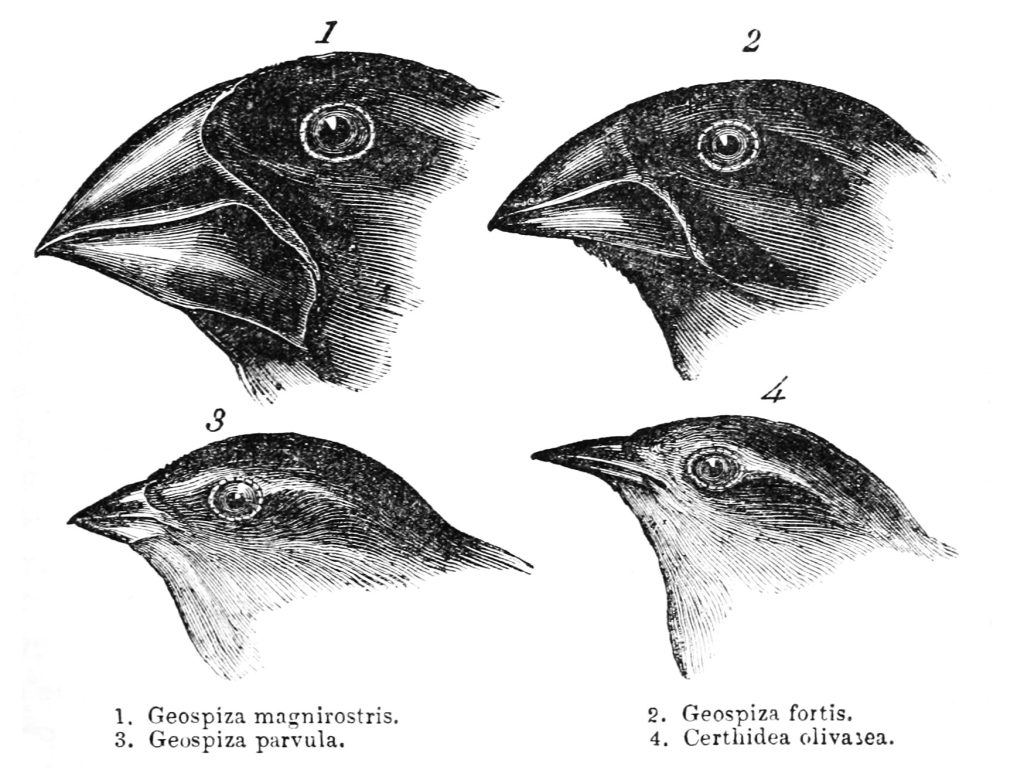
An example of the role of geographical isolation in evolution was observed by Charles Darwin in the Galapagos Islands, and was important for Darwin’s thought process in devising the theory of evolution by natural selection. Finches are birds which typically have large beaks, adapted to cracking hard seeds. However, in the Galapagos Islands, Darwin observed about 18 species of finches, with widely varying beaks, and living in different locations and ecological niches on the islands. Darwin speculated that a small number of birds had arrived on the islands some time previously and had evolved their contrasting characteristics to occupy a variety of niches that were previously unexploited by birds. Modern genetic research has shown that the approximately 18 species of finches found on the Galapagos Islands are probably descended from a single flock of about 30 individuals that arrived at about ~1 Ma.
Genetic drift and isolation effects
It’s now known that some mutations and variations are quite neutral for survival: they neither confer an advantage nor a disadvantage. They may, nonetheless show changes over time in a population resulting from purely random effects which increase the frequency of one gene over another. Genetic changes which are not the result of selection pressure, but which arise from these purely random effects, are known as genetic drift.
By analysing such changes using DNA-sequencing it’s now possible to estimate how long ago two species may have diverged, a type of study known as molecular phylogenetics.
A genetic “bottleneck” occurs when only a very small number of individuals survive a major event, or migrate to a new location. Because they are a very small sample of the overall variability of the population, this small number of individuals may carry a range of genes which is somewhat unrepresentative of the previous population as a whole. If that remote population then grows, the genetic characteristics of the small number of survivors will tend to be replicated in all the descendents; the descendents will show a different range of variation when compared with the ancestral population.

This is the reason why DNA testing of humans is sometimes able to suggest the location in the world where a person’s ancestors originated.
A brief history of life
The fossil record
Sediments are materials deposited, typically in layers, on the surface of the Geosphere that are ultimately derived from the weathering of older parts of the Geosphere. Sediments may become solidified (usually by the precipitation of minerals as cement between the sediment grains) as sedimentary rocks. Sediments and sedimentary rocks may contain and preserve the remains and traces of organisms that lived at the time of deposition. Those remains and traces are fossils.
The vast majority of living things decay away, or are eaten, after death and leave no fossils. Most of the fossils that do survive preserve only the hard parts (skeletons, including shells) of organisms. Only in very exceptional circumstances are the soft parts (muscles, organs) of animals preserved. Remember, in viewing reconstructions of past living things, that these are educated guesses about what the organism looked like!
Fossils may consist of:
- The original material of the organism;
- Chemically altered skeletons;
- Casts and molds recording the shape of the organism as an impression in the surrounding sediment;
- Trace fossils, such as trackways and burrows, left by the organism when it was alive.
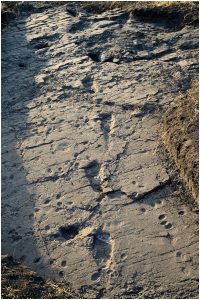
Thus it’s not actually necessary for an organism to be “fossilized” in order to make a fossil.
Fossils provide a partial record of evolution. For example, many soft-bodied organisms not preserved. The brief history of life that follows in the next sections is based not just on fossils, but also on what has been discovered about the relationships between living species through DNA sequencing.[11]

We know the order of events (relative ages) of major events in the history of life from fossils found in rock strata, because of the principle of superposition. Older layers occur below younger layers, so geological time scales are typically shown with the oldest ages at the bottom.
Numerical ages in the time scale typically come from isotopic dating of mineral grains contained in igneous rocks; sedimentary rocks are inherently difficult to date, but we are increasingly able to put numbers on the different periods named in the geologic time scale, based mainly on situations where igneous and sedimentary rocks occur together. (For more details, see the chapter on Geologic Time.)
In the timescale shown here, the ages at the right are in Ma (mega-annum or millions of years before present). We also use Ga (giga-annum, or billions of years before present.) The most up-to-date estimates can be found at www.stratigraphy.org
For a general overview of major events in Earth history, it’s worth knowing the names and approximate age limits of the Eons, and of the three Eras within the Phanerozoic Eon.
Archean time: chemical evolution and prokaryotes
Pre-cellular life
The earliest stages in evolution probably took place in Archean or possibly Hadean time, and must have involved polymers combining without surrounding cell membranes. At this time the Earth’s atmosphere had no oxygen, consisting primarily of carbon dioxide and nitrogen. Nitrogen may have been delivered to the early biosphere as a result of lightening strikes, and early sources of energy may have been from chemosynthesis around hot springs on the sea floor.
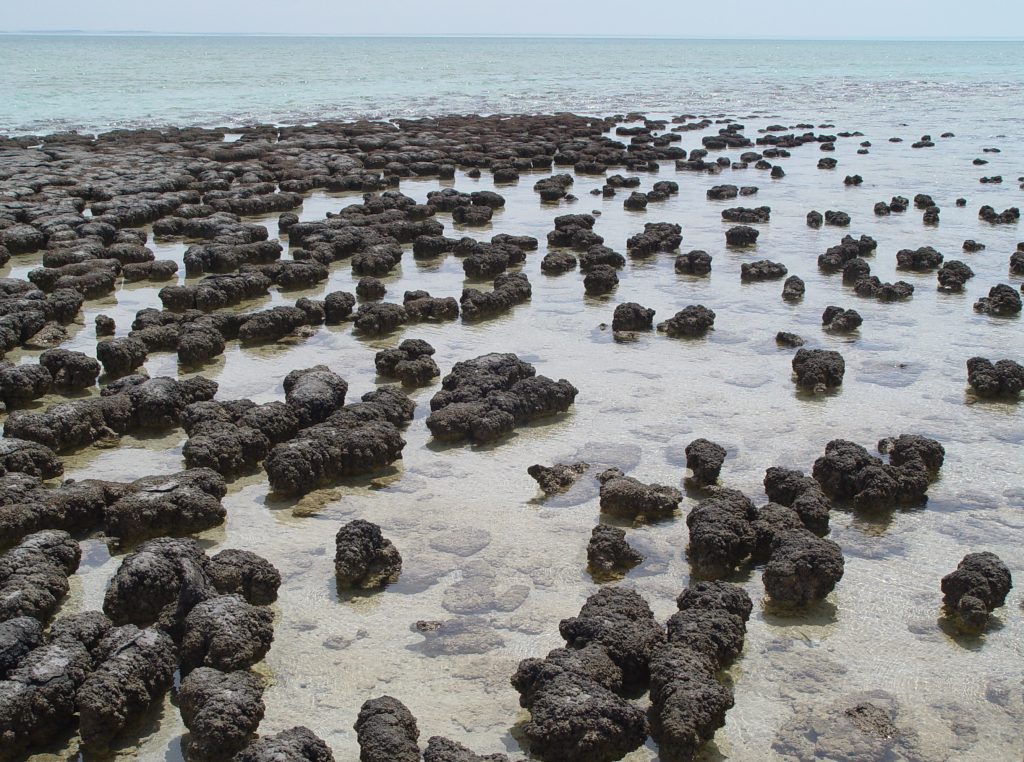
Prokaryotes
The first claimed fossils of prokaryote cells occur around 3.5 Ga. These early cells trapped energy to make carbohydrates using chemosynthesis or photosynthesis. In places, they produced the first fossils that are visible without a microscope: stromatolites are domes of calcium carbonate with finely layered structure, deposited by living films of photosynthetic prokaryotes called cyanobacteria. Because the air contained no oxygen, these early cells probably gained energy by fermentation reactions (anaerobic respiration) such as the following:
C6H12O6 → 2 C2H5OH + 2 CO2
Carbohydrate => ethanol + carbon dioxide

The energy yield of this reaction is only 74 kJ/mol, much less than the energy output of modern aerobic respiration that yields ~2800 kJ/mol from the same carbohydrate:
e.g. C6H12O6 + 6O2 → 6H2O + 6 CO2
Carbohydrate + oxygen => water + carbon dioxide
Oxygen was probably poisonous to early organisms because it is so reactive. However, the evolution of photosynthesis led to increasing production of oxygen as a by-product.
e.g. 6H2O + 6 CO2 → C6H12O6 + 6O2
Water + carbon dioxide => carbohydrate + oxygen
Early photosynthetic organisms probably disposed of oxygen using reduced elements like reduced iron Fe2+ dissolved in sea-water, converting it to oxidized iron Fe3+, leading to the deposition of iron-rich sediments like banded iron-formation.
Proterozoic time: Photosynthesis and the rise of oxygen
The great oxygenation event
Stromatolites continued to be abundant during the Proterozoic Eon, forming extensive layers of limestone built by cyanobacteria (formerly “blue-green algae”).
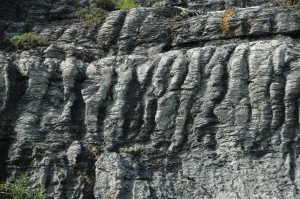
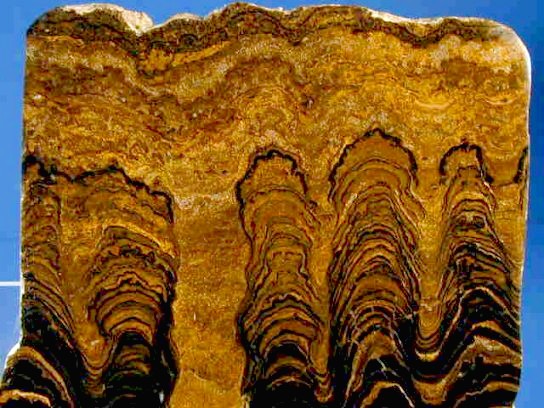
Huge amounts of carbon dioxide were converted to oxygen and organic matter during photosynthesis, and the first significant amounts of oxygen appeared in the atmosphere during what is known as the great oxygenation event between 2.4 and 2.0 Ga
The large increase in oxygen production led to widespread oxygenation of dissolved Fe2+ to insoluble Fe3+. The result was thick deposits of hematite Fe2O3 and other minerals containing oxidized iron that make up banded iron formation (BIF). Many of the worlds major iron deposits, that are mined for the production of industrial iron and steel, date from this time in Earth history.
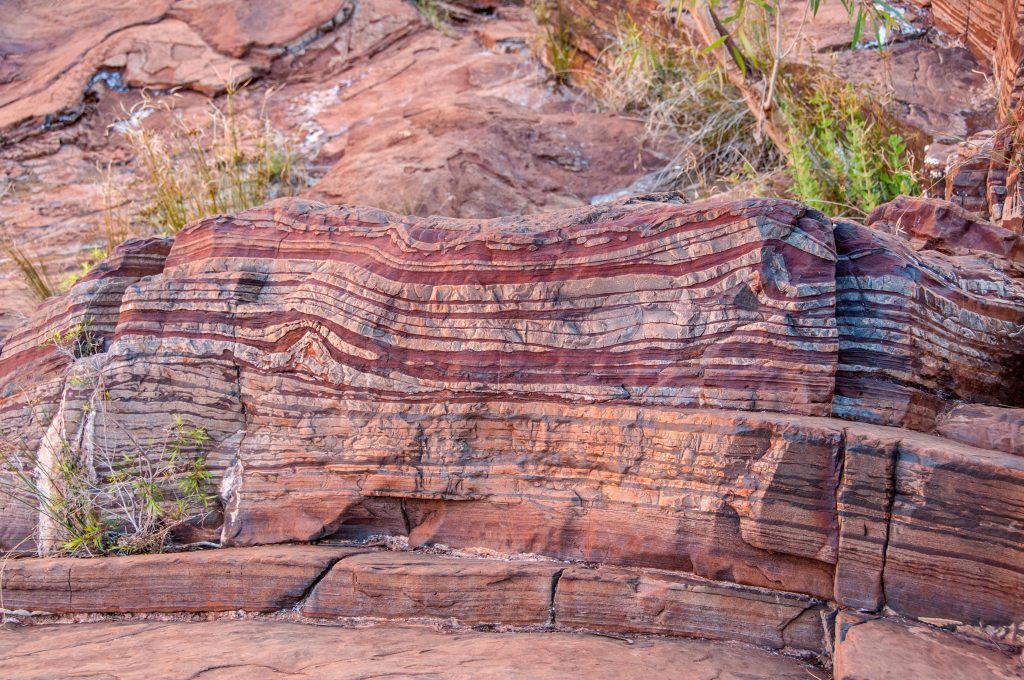
Eukaryotes
Once organisms had evolved to protect themselves from free oxygen in water, this led to much more efficient aerobic respiration, and allowed larger body sizes. Eukaryotes, cells consisting of a separate nucleus surrounded by cytoplasm containing organelles, probably originated between about 1.8 and 1.2 Ma, the time of the first definite eukaryote microfossils.
It’s likely that the first eukaryote evolved from a member of the Archaea which began to live in conjunction with bacteria in a cooperative relationship called symbiosis. The symbiotic bacteria eventually evolved, as part of a process called symbiogenesis, to become organelles called mitochondria, the energy producing “powerhouses” within eukaryotic cells. Another, probably slightly later form of symbiosis accommodated cyanobacteria within the cytoplasm of certain eukaryotes. These evolved into chloroplasts, organelles that are found in all photosynthetic eukaryotic plants.
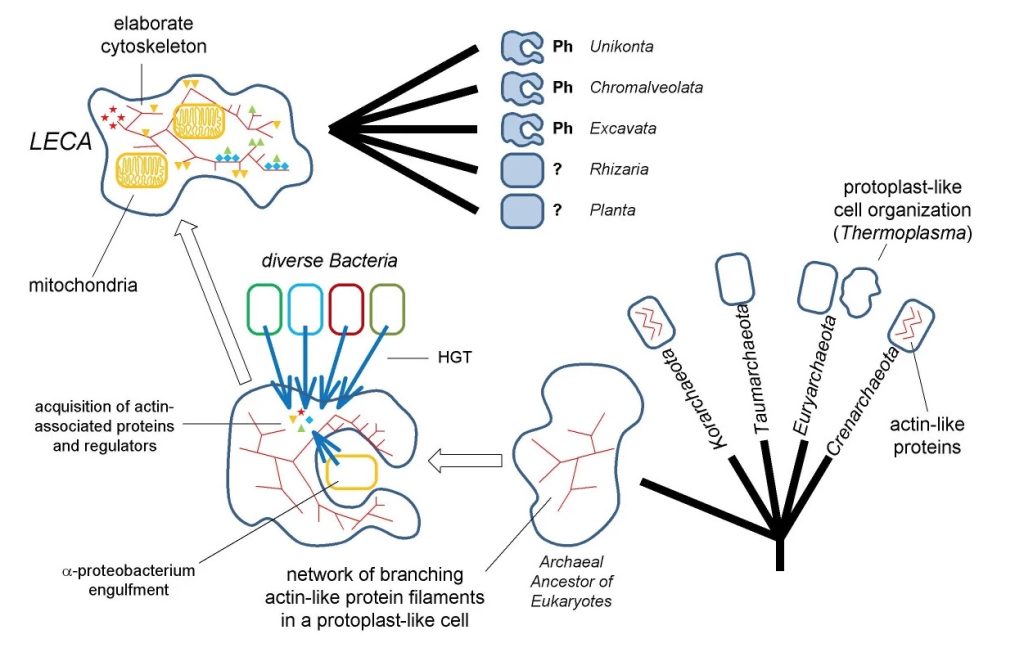
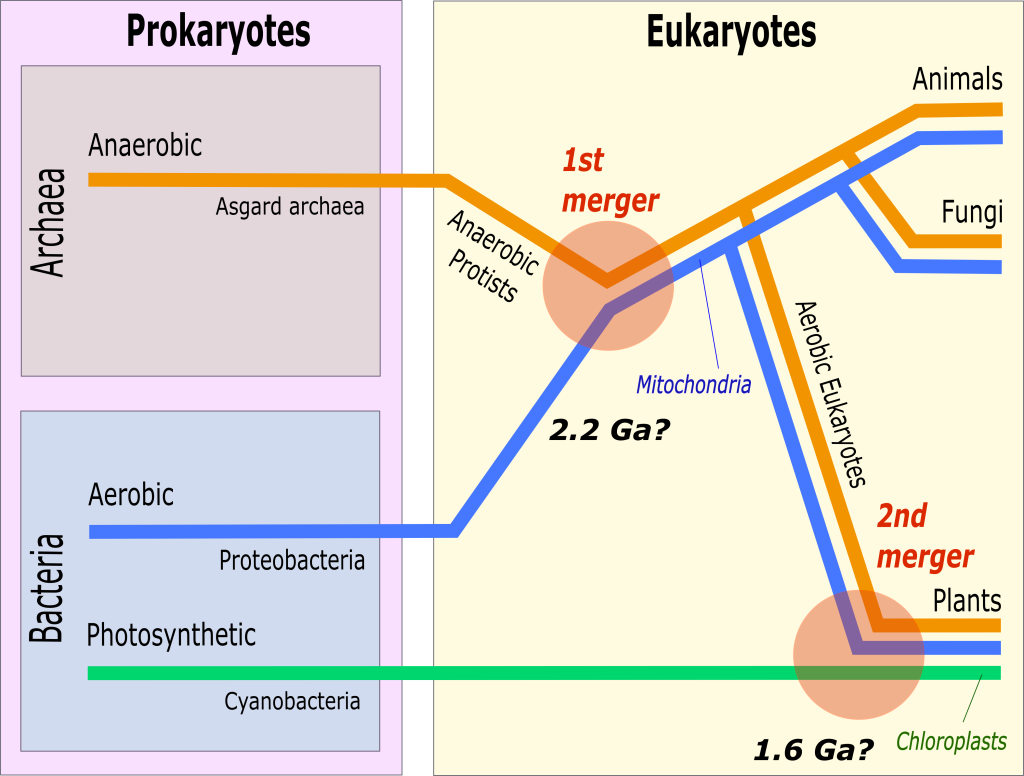
Snowball Earth
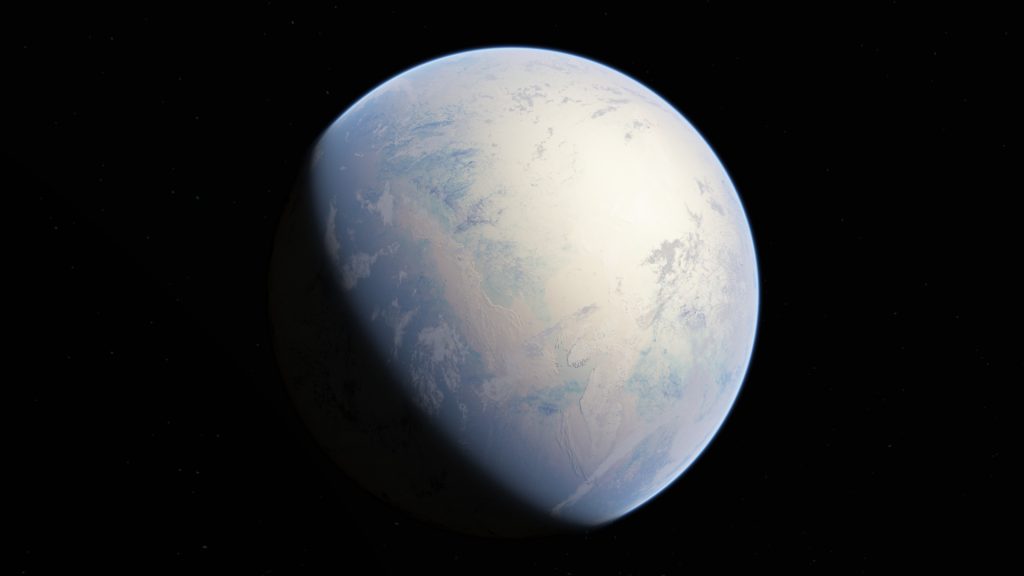
Around 700 Ma Earth experienced some of its most extreme climate fluctuations. The reduction in the amount of carbon dioxide in the atmosphere led to a reduction in the amount of energy trapped in the atmosphere (a reduction in the greenhouse effect) and a fall in temperature. The Sun probably produced slightly less energy in the Proterozoic than it does at the present day, with the result that ice-caps and ice sheets began to grow, recording their presence with features like glacial striations and glacial till on land, and dropstones (large clasts carried out to sea by floating ice) and dropped into marine sediment.
The increased ice-cover increased the Earth’s albedo, reflecting more solar energy into space, leading to further cooling, a process of positive feedback. Eventually much of the land and ocean was covered by ice. Measurements of the Earth’s ancient magnetic field preserved in rocks associated with the glaciers have shown that ice was present even close to the equator.

At least two main phases of ice cover occurred.
- Sturtian 760–700 Ma
- Marinoan 620–590 Ma
Each time snowball Earth conditions occurred, the climate eventually became so cold that photosynthesis was slowed down. Earth’s climate was able to recover as a result of the emission of carbon dioxide into the atmosphere by volcanoes, which restored the greenhouse effect and eventually allowed the Earth to return to warmer conditions.
 Multicellular organisms
Multicellular organisms
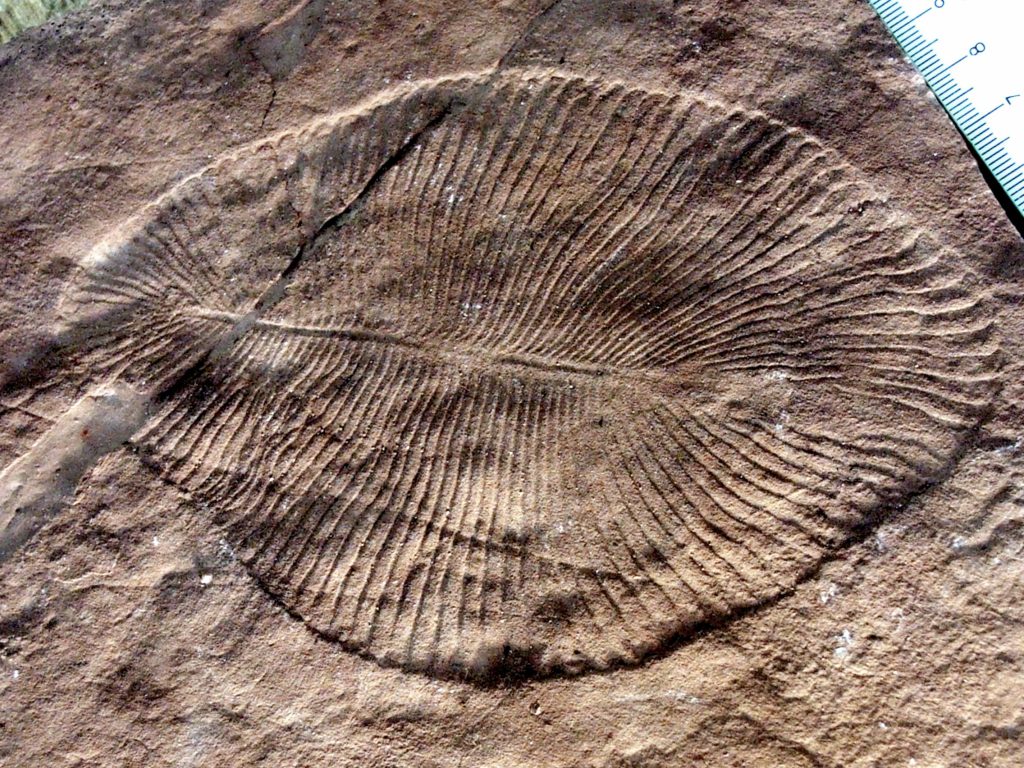
The next big step in the evolution of life was the development of multicellular organisms. The earliest known multicellular forms belong to the Ediacaran fauna named for Ediacara in Australia. The Ediacaran fauna lived on both shallow and deeper parts of the sea floor. These enigmatic organisms had no obvious mouths or guts, and no clear sensory organs. They apparently left no descendents, becoming extinct around the beginning of the Phanerozoic Eon around 540 Ma.
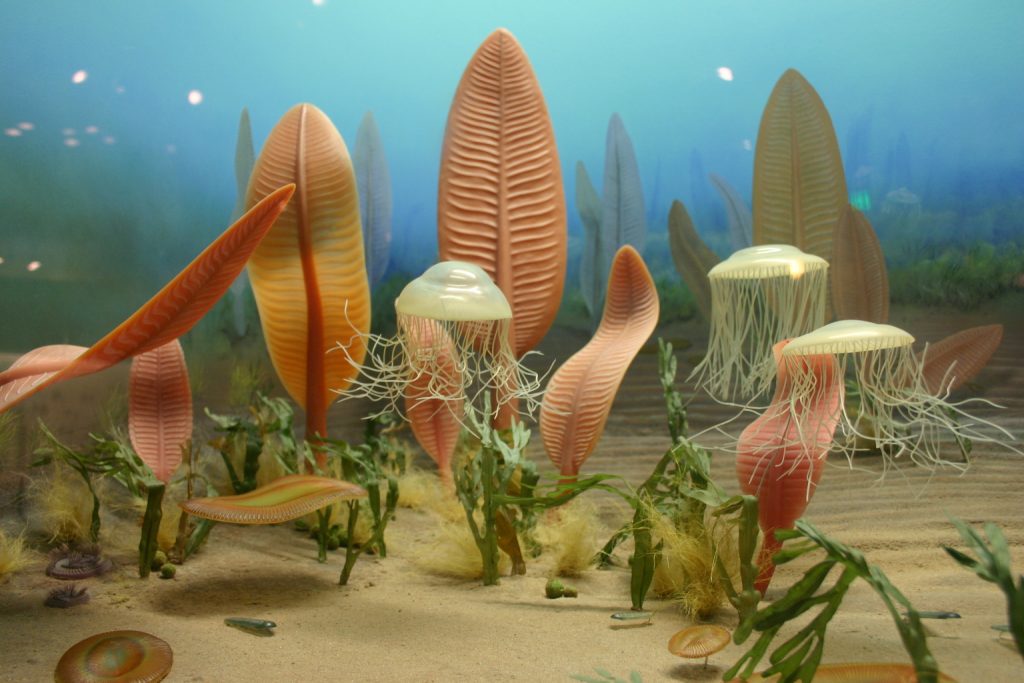
 Phanerozoic time: Animals and plants
Phanerozoic time: Animals and plants
The Phanerozoic Eon represents “only” about the last 540 million years of Earth history – only about 12% of geologic time – but it is certainly the best known. The word Phanerozoic means “evident life” and is used because this is the part of Earth history where we have abundant fossils. In fact, fossil species appeared and disappeared so rapidly during the Phanerozoic Eon that we can subdivide this part of Earth history into literally hundreds of time zones based on the characteristic fossils that existed.
Paleozoic Era (~540–250 Ma)
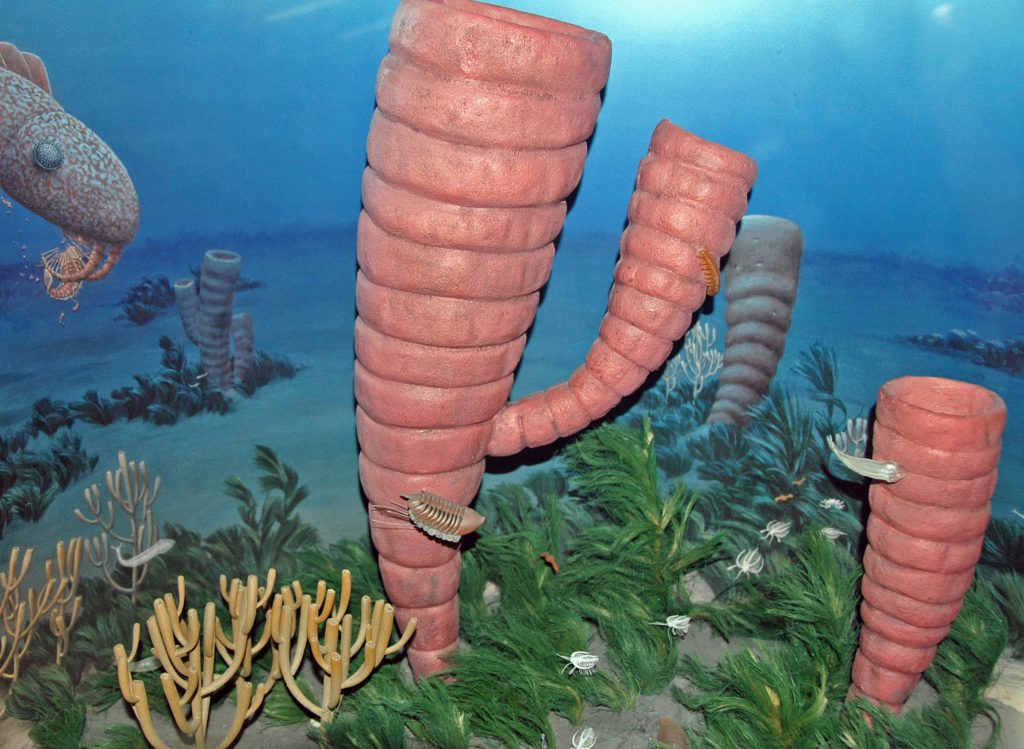
The first part of the Phanerozoic Eon is designated the Paleozoic (“old life”) Era, which lasted from about 540 Ma to about 250 Ma[12]. (Recall that the symbol Ma stands for mega-annum or millions of years before present.). It began with a huge proliferation of fossil types that is called the Cambrian explosion. (The Cambrian Period is the first part of the Phanerozoic Era.) The Cambrian explosion involved the proliferation of marine multicellular animals that are clearly related to those that are around at the present day. It is not certain what provoked this rapid diversification of animal life. It may have been an increase in the proportion of oxygen in the atmosphere. One of the first developments was the evolution of a gut – a tube extending through an animal from a mouth at one end to an anus at the other. Prior to the Cambrian, the animals that were around seem to have been more like modern jellyfish – animals that take in food and expel waste through the same opening. Others may have been filter-feeders that captured small particles of food on their body surfaces. The new body plan was probably more efficient and provided many more opportunities for animals to pursue and eat plants and other animals.
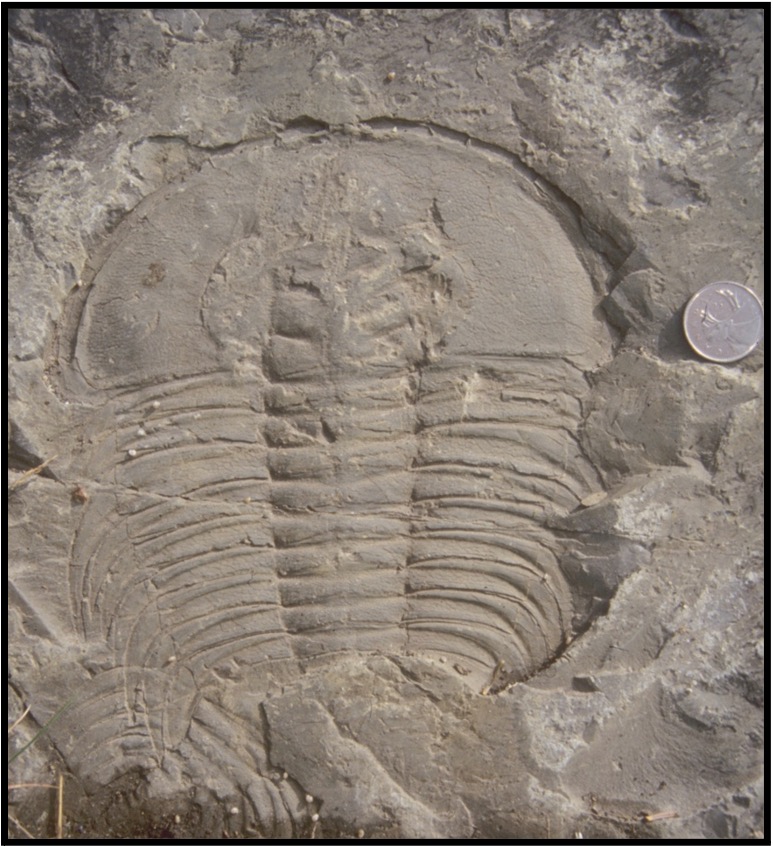
The development of this new predatory style was probably followed by the development of defences against predators – mineralized hard parts that formed a shell. In the Cambrian we see ancestors of modern arthropods (such as crustaceans and insects) with jointed exoskeletons, and molluscs (ancestral snails and clams, for example) with one or two-part shells. The first chordates – animals with gills for breathing and a stiff rod that eventually gave rise to the vertebrate backbone – also appeared in the early Paleozoic seas.
Most of these new animal types existed at first only in the sea, but later in the Paleozoic era, around 420 Ma, autotrophic plants, followed by heterotrophic animals, began to invade the land as well. Until this time, the surfaces of the continents must have looked very different from today, perhaps with only small lichens and fungi populating the land surfaces. In the mid-Paleozoic era the first spore-bearing plants, related to modern ferns, appeared on land. The first land plants seem to have done most of their photosynthesis in the stems, perhaps because the high partial pressure of carbon dioxide made it relatively easy to extract. However, as the amount of atmospheric CO2 declined, competition and natural selection led to the development of large leaves and taller and taller stems, held up by an organic polymer called lignin, the main component of wood. These plants formed the Earth’s first forests, that flourished during the Carboniferous Period of the Paleozoic Era, named for the major deposits of coal that are found in eastern North America and in Europe, regions that lay on the equator at that time in Earth history. These coal deposits record the start of the tropical rain forest biome, one of the most productive biomes that has existed from the late Paleozoic Era until the present.
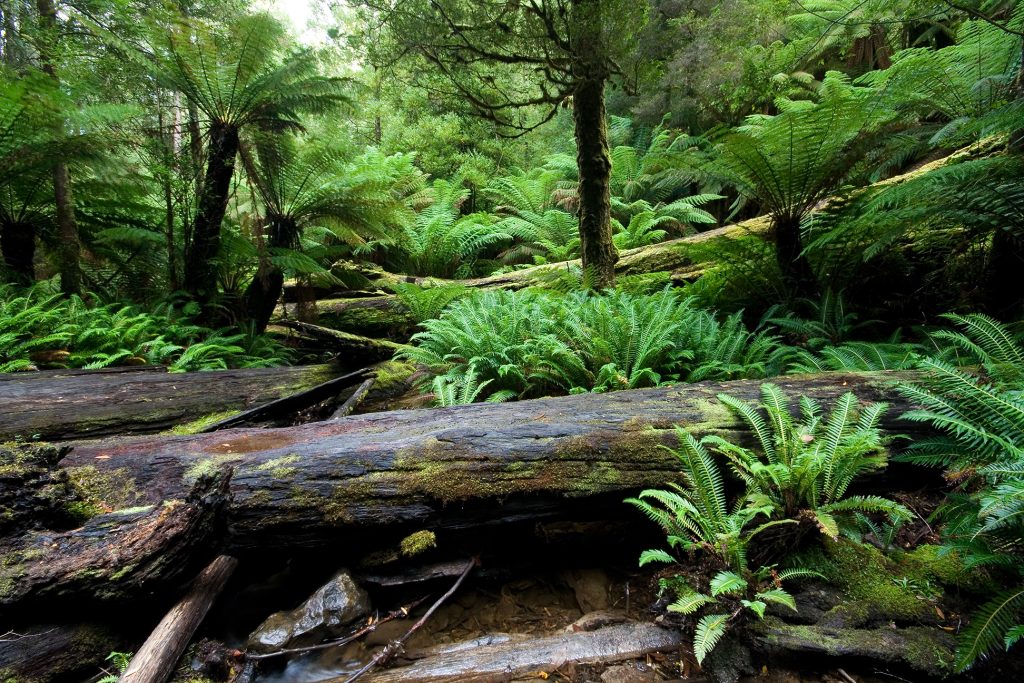
Coal forms from peat deposits that undergo compaction down to perhaps one eighth of their original thickness, and lose much of the hydrogen, oxygen, and nitrogen to make a rock that mostly (65 to 97%) carbon. The carbon in coal deposits comes from atmospheric CO2 that was reduced by photosynthesis. There is circumstantial evidence that the surge in photosynthesis that resulted from the establishment of tropica rain forests led to a corresponding surge in atmospheric oxygen levels. For a time thes were probably higher than at present day. Values above 30% have even been suggested. Although it’s difficult to make direct measurements of ancient oxygen levels, there is evidence in coal deposits that forest fires may have occurred in quite damp, swampy places in the Carboniferous Period. This may have been possible with extra oxygen in the atmosphere.
<photo of fusain from coal ball.>
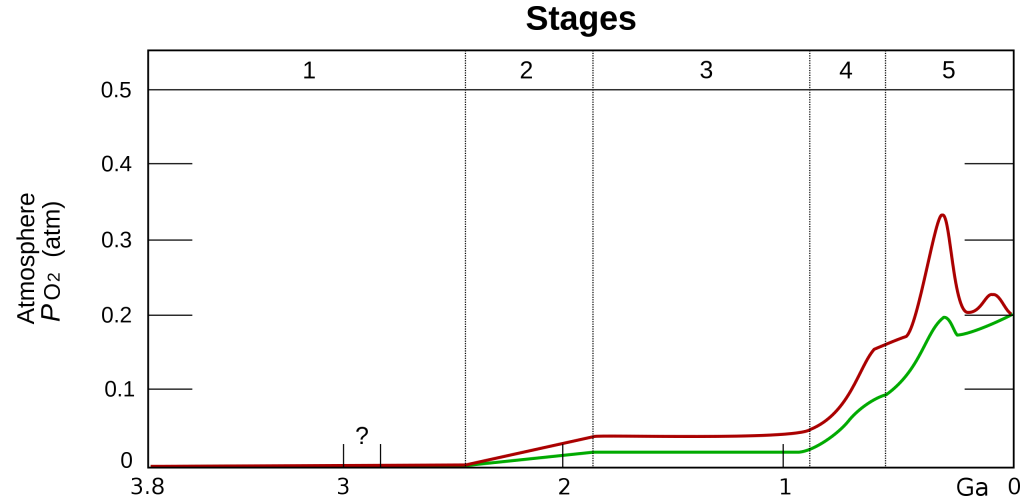
Mesozoic – age of reptiles (~250 – 66 Ma)
The Mesozoic Era is famous for the widespread occurrence of large land chordates including dinosaurs. Dinosaurs actually belong to two lineages amongst the reptiles. One of these branches gave rise to the birds, so it’s pretty clear that reptiles and birds belong to the same taxon. In that sense, birds represent dinosaurs that made it through a great extinction event that occurred at the end of the Mesozoic era.

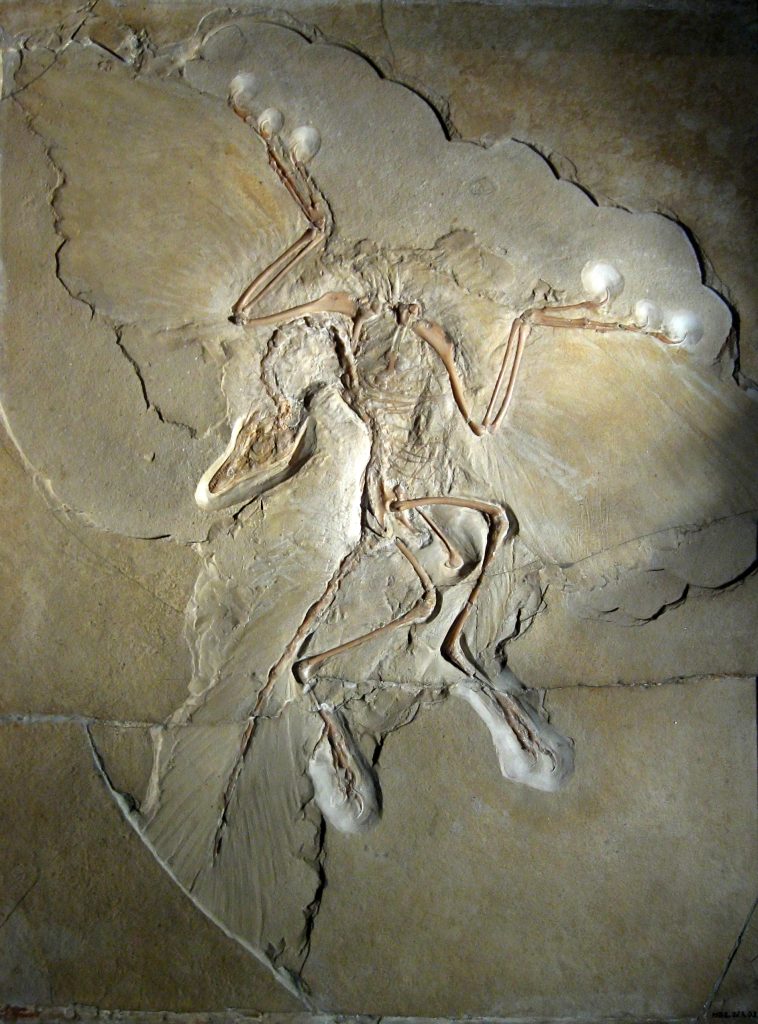
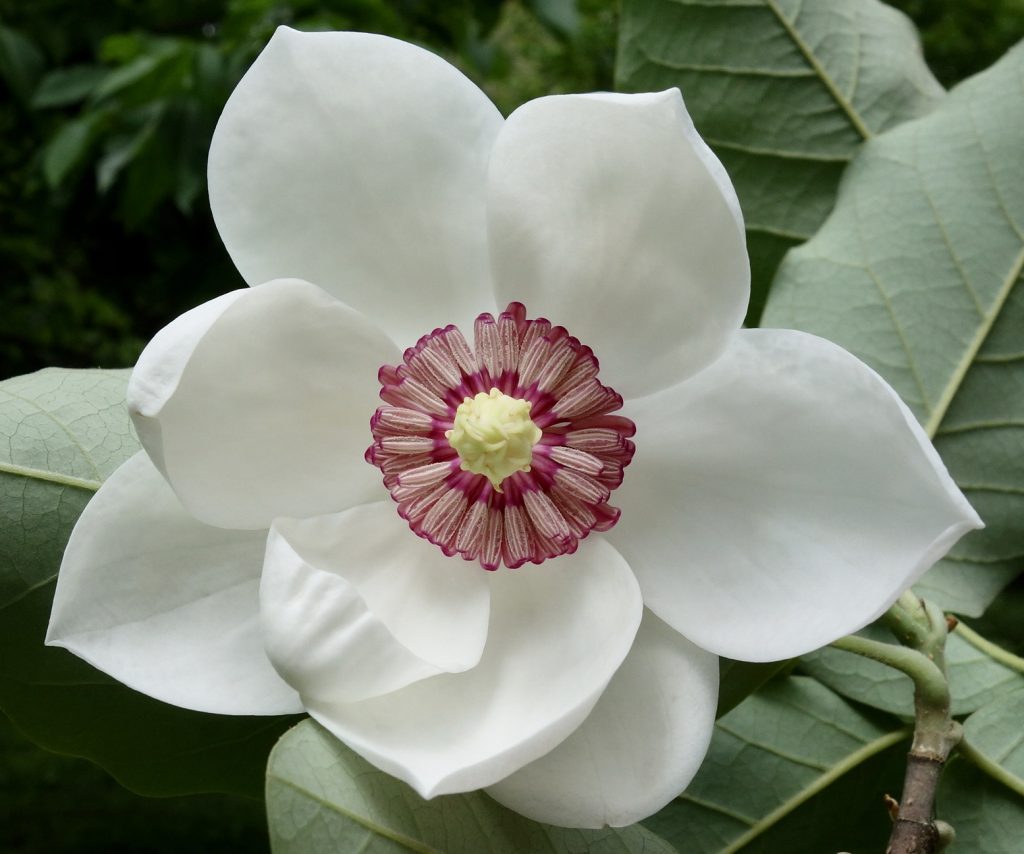
In terms of overall biosphere evolution, some other developments were perhaps just as significant, maybe more so, than the dinosaurs. The Mesozoic Era saw the first appearance of flowering plants: this is the group of plants that came to dominate the land biomes in the Cenozoic Era. Flowering plants display a close symbiotic relationship with insects: flowers evolved to attract insects to achieve reproduction (by pollination), and insects co-evolved characteristics that allowed them to collect food (nectar, etc.) from flowers. The Mesozoic Era also saw the first mammals, although mammals did not assume their dominant position in the biosphere on-land until the Cenozoic era.
The Mesozoic era ended at a major extinction event. Most Earth scientists regard this extinction, at about 660 Ma, to have resulted from the impact of an asteroid. Indeed an impact strucure has been found at Chicxulub in modern Mexico. It’s not exposed at the surface, but is detectable buried within the crust beneath later sediment layers. The remnants suggest a crater that was about 180 km accross, produced by an asteroid 10 to 20 km in diameter.
The event at the end of the Mesozoic Era was just one of a number of major extinction events that affected the Earth during the Phanerozoic Eon. An even larger extinction marke the boundary between the Paleozoic and the Mesozoic Eras at about 250 Ma. That event appears to have led to the loss of ~80% of marine species, but its cause is unknown and controversial. It doesn’t appear to have been quite as sudden as the event at the end of the Mesozoic Era, and so probably was not the result of an impact. Possibilities include major volcanic eruptions, and major changes in atmospheric carbon dioxide.
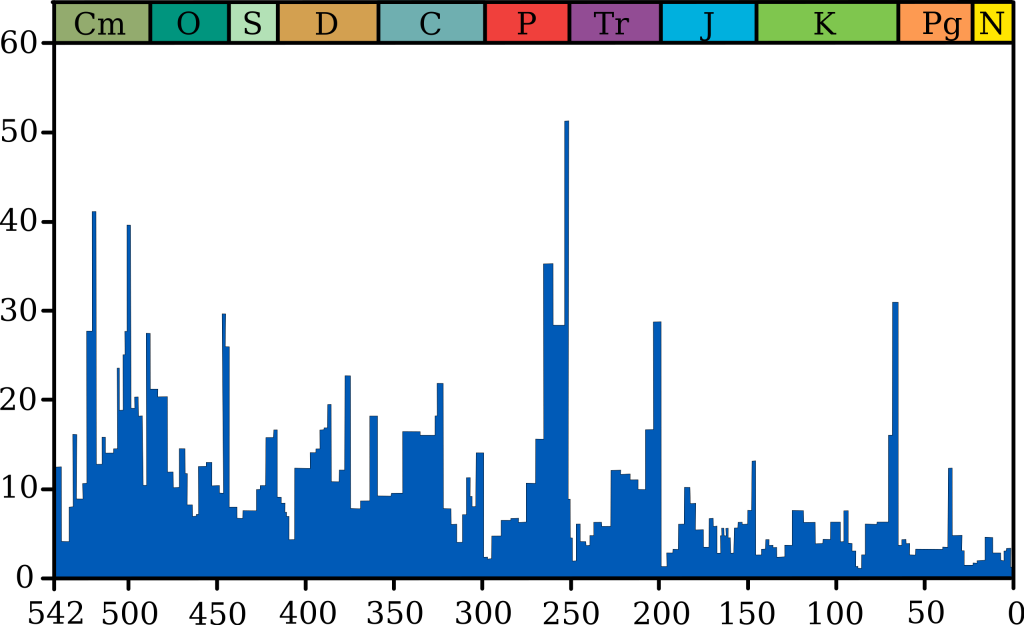
Some would argue that humans are in process of generating a new major extinction event at the present day, by causing environmental change in habitats across the planent.
Cenozoic – age of mammals (since 66 Ma)
Extinction events tend to be followed by rapid appearance of new taxa occupying empty ecological niches: a process known as adaptive radiation. In the adaptive radiation that occurred in the early Cenozoic Era, mammals occupied many niches formerly occupied by dinosaurs. A look at the evolutionary tree of mammals shows that almost all the familiar groups of modern mammals appeared around the start of the Cenozoic Era.
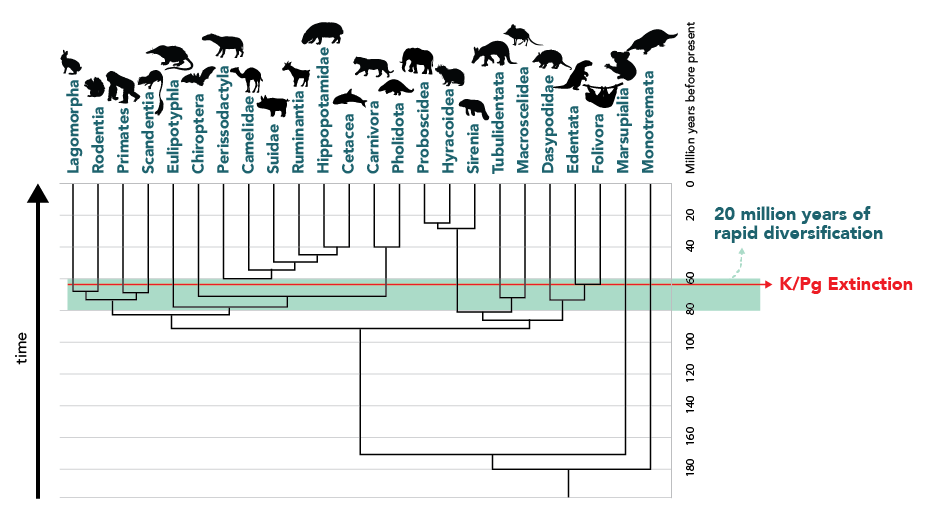
Many of the events of most significance to humans occurred towards the very end of the Cenozoic Eara – although to speak of the “end” of the Cenozoic is not really correct, because the Cenozoic Era continues at the present day.
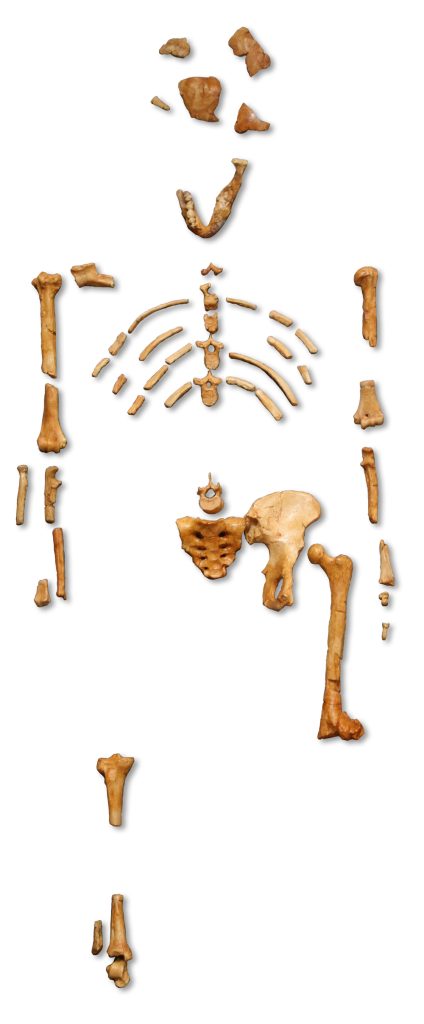
Humans belong to an order of mammals called the primates, that include lemurs, monkeys and apes. The lineage that led to humans probably branched from its closest living relatives, the chimpanzees, sometime between 8 and 4 Ma. Humans differ from other apes in their walking and running posture, which is much more upright, and in the much larger size of their brains. For much of the 20th century there was controversy over which of these adaptations came first, but the discovery of a 3.3 Ma fossil of Australopithecus afarensis, nicknamed Lucy, in 1974, made it clear that upright walking came first. The Lucy fossil skeleton, and others found in the same area, had human-like legs and feet, and footprints found nearby confirmed that Australopithecus walked upright. Nonetheless, Australopithecus had a skull not much larger than that of a modern chimpanzee.
At about 2.6 Ma, the Earth entered a series of glacial and interglacial periods driven by Milankovitch cycles, particularly those occurring with 100,000-year and 40,000-year periodicity. This alternation of cold and warm, glacial and interglacial periods accompanied much of the evolution of our own genus Homo which was distinguished by a rapid increase in brain-size relative to the rest of the body. Several species of Homo have been identified, and there’s quite a lot of controversy in their taxonomy, but by most accounts, our own species H. sapiens appeared only at about 0.3 Ma (300,000 years ago).
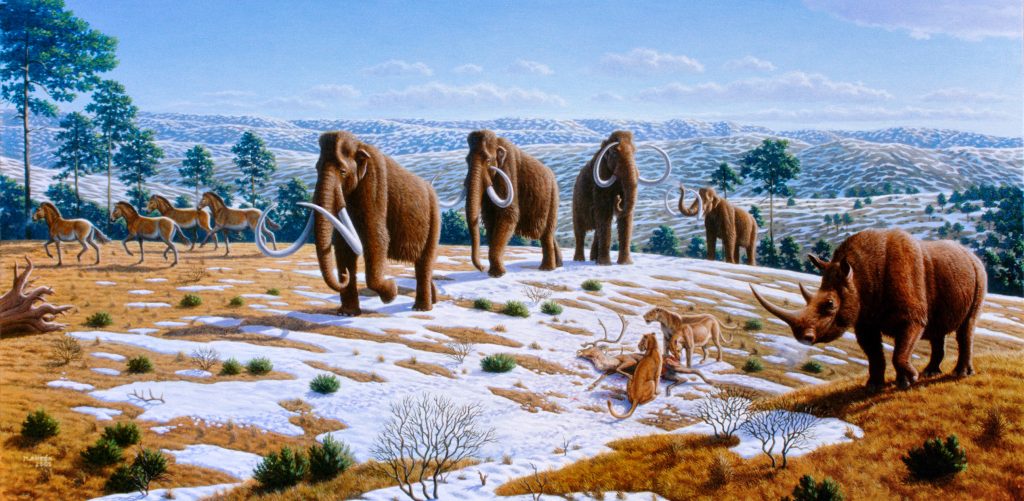
The major impacts of H. sapiens on the Geosphere, Hydrosphere, and Atmosphere and the rest of the Biosphere have occurred in the last 10,000 years, following the development of agriculture, which has radically modified the surface of the Earth. Despite what seems like a long history, the influence of humans on the planet as a whole has taken place in a time interval that seems like a blink when viewed in relation to the whole history of the Earth. Nonetheless, Homo sapiens has possibly had a larger impact on the Earth’s surface than any species since the Cambrian explosion. Human activity can be detected by changes almost everywhere on Earth, and human impacts on the surface of our planet are clearly visible from space. The impacts of human activity on climate systems are considered in more detail in the chapter on climate and climate change.
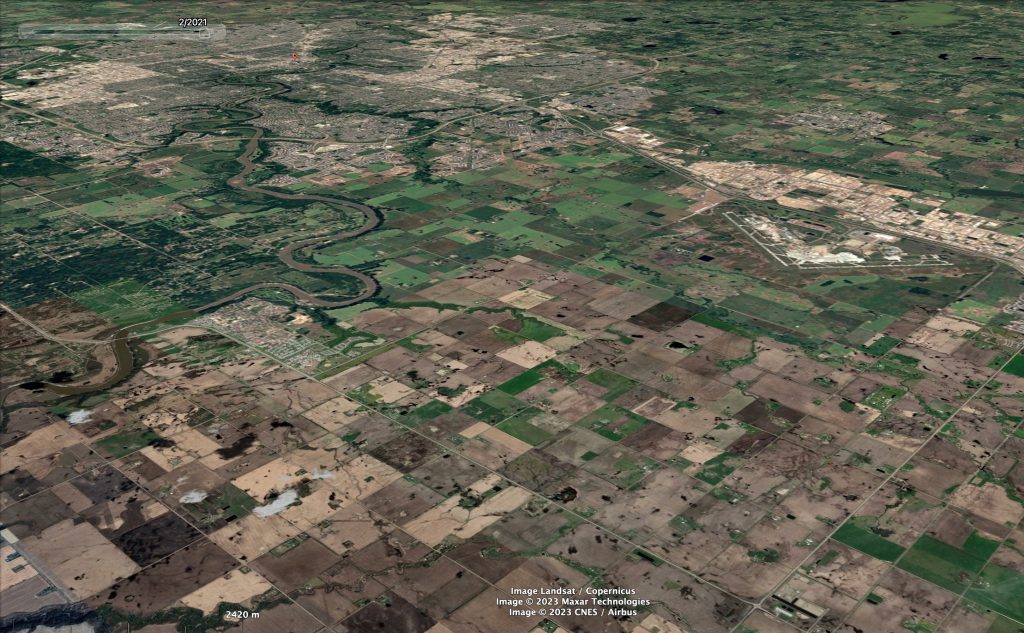
- Note that in Latin, a letter s at the end of a word does not typically indicate a plural, and in fact the word "species" is identical in the singular and plural in Latin, so we can talk about one species or many species. (If you think this is strange, think about the English word "sheep"). ↵
- The plural of genus is genera. ↵
- If you are hand-writing these names, or using a typeface that does not allow italics, you can use underlining instead. ↵
- The odd-looking Latin word Equus is usually pronounced "Eckwus" in English. ↵
- In popular writing, the name of the famous dinosaur species is often abbreviated T-rex. This is incorrect. ↵
- The Latin word Homo referred to any human, male or female. Different Latin words "vir" and "femina" referred to male and female humans. However, both homo and vir were translated as "man" in English, resulting in the use of "man" as a name for the human species. Although some scientists have maintained that they can distinguish between the gendered and non-gendered usages, significant ambiguities can result in both the reading and writing of texts that use "man" in two different ways. Modern anthropology discourages the use of "man" and "mankind" as names for the human species, and we follow this recommendation here. ↵
- Notice also that "sapiens" is another Latin word in which a final letter s does not designate a plural. (Its plural is sapientes.) Do not be tempted into saying "sapien" — there is no such word. ↵
- Protista are not a valid kingdom froM some taxonomic viewpoints, because some descendents of their last common ancestor are in different kingdoms (ie the groups are paraphyletic). However, this convenient classification emphasizes the unicellular/multicellular distinction and is used here for convenience. ↵
- Although the changes in peppered moth populations were the result of human activity, we use the term natural selection, rather than artificial selection, because the changes were not the result of a deliberate attempt by humans to breed black moths! ↵
- The original work by Bernard Kettlewell, carried out in the 1950s, was criticized in the late 1990s and early 2000s, when Kettlewell's original notes could not be found, and it was claimed that the moths did not habitually rest on tree trunks where Kettlewell had illustrated them. One publication even suggested the work was fraudulent, and there were calls for the removal of accounts from textbooks. However, Kettlewell's experiments were repeated with over 4800 moths by Michael Majerus between 2001 and 2007, replicating Kettlewell's statistical results with more data. Majerus's additional observations showed that moth's resting places were more frequently on tree branches than the main trunk, and this was where the selective predation mainly occurred. ↵
- DNA decays with time so sequencing is not possible with fossil material older than about 1.5 Ma. ↵
- All isotopic ages have some associated uncertainty. The text shows approximate "round number" estimates of the start and end of the Paleozoic Era, which is defined by changes in the biosphere. As the precision of isotopic, numerical dates improves, these dates may move up or down by a few million years. The accompanying graphic shows more precise values that are best estimates as of 2023. ↵
The categories and methods used by biologists to classify living organisms
The smallest conventional taxonomic group; typically defined as a group of organisms capable of reproducing and producing with viable offspring that can also reproduce. Species are grouped into genera.
The taxonomic group above species and below family.
Deoxyribonucleic acid: A double-stranded nucleic acid that preserves genetic information
Units of DNA in an organism which code for particular proteins, and, therefore, particular characteristics.
Changes in the genetic material carried by a cell or an organism caused by copying errors during cell division, by exposure to certain chemicals and types of radiation, or other essentially random processes
The selective breeding of organisms with traits desired by humans in order to produce offspring more suitable for human purposes. Examples include varieties of dogs and crops.
The action of environmental conditions in causing natural selection by favouring the survival of certain variants of a species over others.
The evolutionary process whereby the environment favours that survival of particular characteristcs in a population
Having undergone evolution
Black coloration seen as a variation in moths.
An organism’s position in an ecosystem.
Evolution that does not arise from selection pressure, but rather from chance.
A method by which DNA from two or more organisms is compared to determine their relatedness
Remains of ancient organisms, buried in rocks
Finely layered (laminated) mounds or pillars of calcium carbonate deposited by cyanobacteria
Unicellular organisms whose cells lack a nucleus and complex organelles
Single-celled prokaryotes capable of photosynthesis and the release of oxygen. Cyanobacteria were responsible for the original oxygenation of the Earth’s atmosphere.
A unicellular or multicellular organism with cells that contain a distinct nucleus surrounded by cytoplasm with organelles
A close association between two organisms, whereby both gain benefits from the relationship
The evolutionary process whereby eukaryotic organisms developed from prokaryotic ancestors: one prokaryote evolved to enclose another in a mutually supportive relationship chloroplasts and mitochondria developed through symbiogenesis.
Organelles within plant cells that contain chlorophyll, and are responsible for photosynthesis in plants and photosynthetic microbes; chloroplasts are descended from free-living cyanobacteria.
The proportion of light that is reflected from the surface of a substance
A climate state in which a majority of the Earth's surface is covered with snow or ice. Snowball Earth conditions are believed to have occurred during several intervals in the Proterozoic Eon.
A diverse group of late Proterozoic extinct organisms of uncertain relation to modern animals
The current eon, following the Proterozoic, from about 539 Ma to the present day, characterized by abundant remains of muticellular organisms
The first era of the Phanerozoic Eon, in which multicellular organisms prominently radiated in the Cambrian Explosion, and multicellular life emerged onto land
A member of the largest phylum of invertebrates, the Arthropoda, characterised by their jointed legs and chitinous exoskeletons. Arthropods include insects, spiders, crustaceans. and several other groups
A phylum of invertebrates which typically produce shells composed of calcium carbonate; Mollusca include snails, clams, and octopus (a group that has secondarily lost the shell)
Animal belonging to the phylum Chordata, characterized by a stiff dorsal rod or notochord accompanied by a hollow nerve cord; includes all vertebrates and a number of smaller, related groups.
An organic polymer found within the cells walls of plants, and especially in wood.
Angiosperms; plants that reproduce via flowers as reproductive organs and fruits as dispersal units.
A class of vertebrates characterized by lactation, three middle ear bones, and hair. Mammals make up the majority of megafauna in the Cenozoic Era.
The position of a species in an ecosystem, including its physical environment, predators, and energy sources
The sudden evolution of a diverse array of taxa from a single clade in the wake of open niches in an ecosystem
An order of mammals that includes lemurs, monkeys, great apes, and humans.
Pertaining to ice or glaciers. During cold episodes of Earth history, glacial periods are periods of more ice cover.
Repetitive variations in the Earth’s tilt, axis orientation and elliptical orbit shape, that cause climate forcing.

